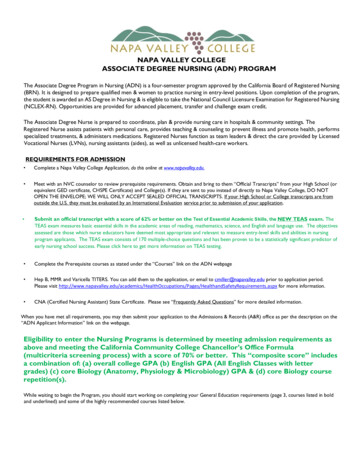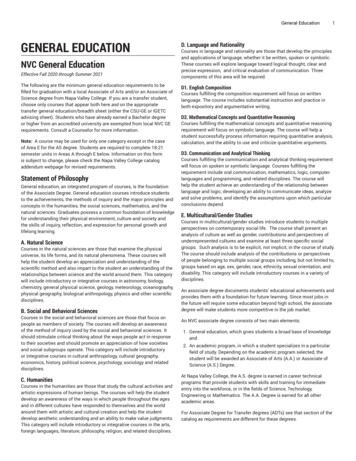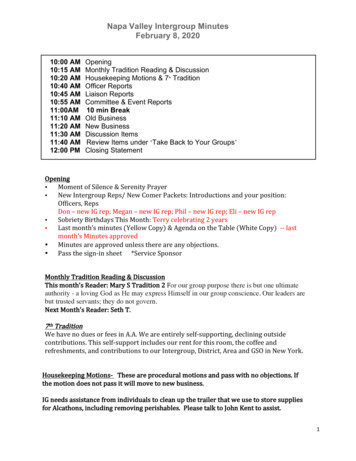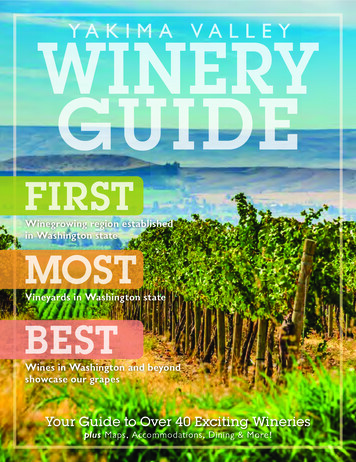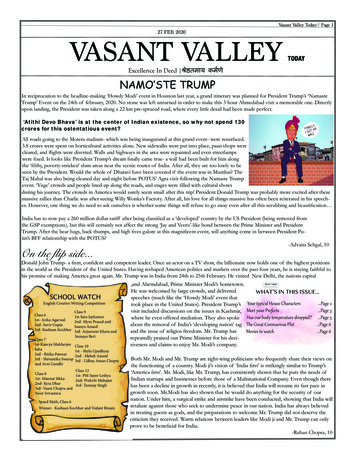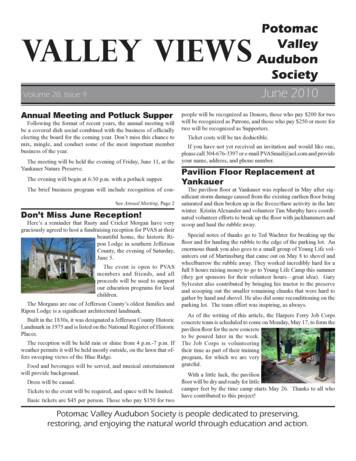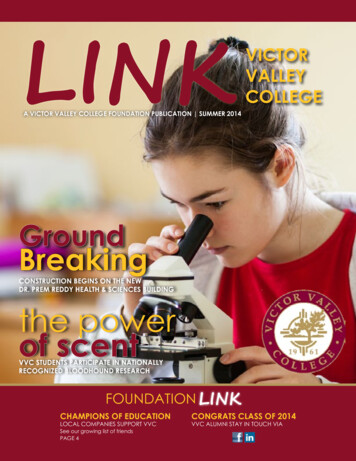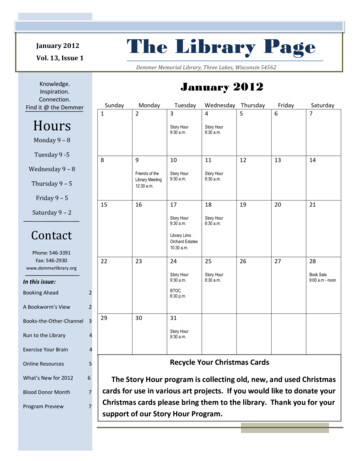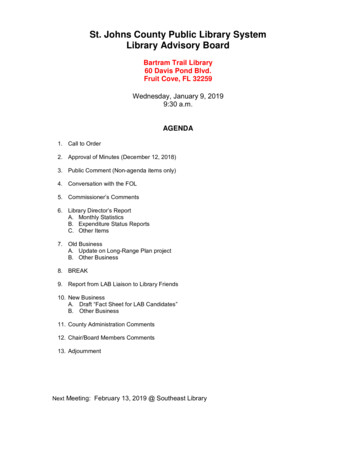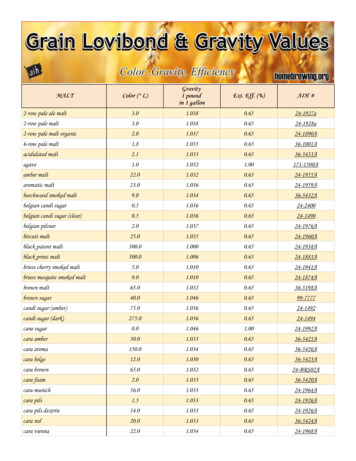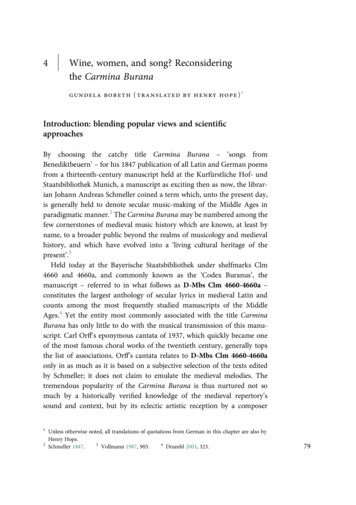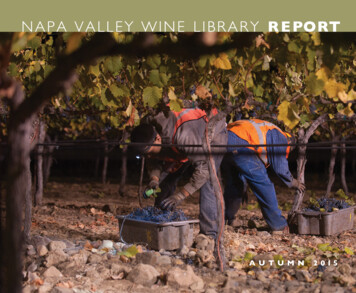
Transcription
N A P A V A L L E Y W I N E L I B R A R Y R E PORTA U T U M N2 015
2016 Calendar of EventsTable of ContentsThursday, January 3 at 7:00 pmBooks on Wine Evening withDick Peterson, author of The WinemakerSaint Helena Public LibraryPresident’s Letter.1Saturday, May 14 from 9:30 to Noon26th Annual Wine Seminar,Winemaking in Two Worlds: Napa Valley and South AmericaEcoLab Theatre, CIA-Greystone, Saint HelenaLunch venue to be determinedSunday, August 14 from 5:00 pm to 7:00 pm54th Annual TastingSilverado Resort & Spa, Napa2015 Winery Alliance MembersArns WineryBaldacci Family VineyardsCakebread CellarsGroth Vineyards and WineryLouis M. Martini WineryNapa Wine CompanyPEJUShafer VineyardsSilver Oak Wine CellarsWhitehall Lane WineryWilliam Hill Estate WineryDUCKHORN VINEYARDS CREW MEMBERSHARVESTING PETITE VERDOT BEFORE DAWN AT THREE PALMS VINEYARDCOVER PHOTOGRAPH: PRISCILLA UPTONEditor’s Letter. 20Books on Wine Eveningwith Alder Yarrow.225TH Annual Wine Seminar“Winemaking in Two Worlds”.453RD Annual Tasting“Toasting the Twelves”. 14Organization and Membership Information.23Napa Valley Wine Library rintingDiana H. Stockton . editor@napawinelibrary.comPriscilla Upton . pbupton@comcast.netTim Kennedy . 707.603.9300Brian Nash Design Company . www.bndco.comMSI Litho . www.msilitho.comYour comments and questions are encouraged:editor@napawinelibrary.com yphone: 707.963.5145
President’s LetterDear Friends,We did learn that vineyards make greatfirebreaks. We heard stories about theValley Fire out of Lake County of housessaved because the neighbor had planteda few rows of vineyard and turned hissprinklers on. The large vineyard on PeriniHill surely stopped the fire from movingen masse into the nearby town of LowerLake. (Go to Google Earth.take a look.)“Looking Down to Middletown”Photograph kindness of LaDonn Morgan-GarciaMaybe it’s time for a little common sense?Hillside vineyards have been stoppedby County regulations because theyinterrupted someone’s “view shed.” Inother words, someone simply didn’t wantto look at a vineyard. Vineyards, becausethey are green and spaced with lots ofbare dirt, provide firebreaks becausethey themselves don’t burn easily andprovide ready access for firefighters andequipment.The American Indians here long beforethe grapevines, understood the nature ofCalifornia’s arid, drought-prone landscape.Lightning regularly lit fires that burnedthe grass and low scrub, clearing outlarge patches for new grass to grow. Ifthe rainstorms didn’t come, the Indiansset fires. Usually these fires moved fastenough to leave the big trees unscathed.There are, in fact, some pines that onlygerminate after a fire. The returninggrassland feeds more animals, the huntingis better, everyone prospers. The Indiansunderstood that they were part of the landand therefore part of the process.PHOTOGRAPH COURTESY E & J GALLO WINERYWe are just through another harvest inNapa Valley. ‘A little light,’ most aresaying but usually the quality goes upas juice content goes down. This year’spicking was very early because of the heatand because of the drought.Perhaps it’s time to apply a little of thissame philosophy to us today. Maybethe current owners of the land are thebest ones to plan for the survival of theirinvestment–be that hillside vineyards,fire trails, water development or irrigatedgrazing land. Maybe it’s time to learn tobe part of our landscape.Sincerely,Carolyn MartiniPresident1
keeping notebooks on the wines he tasted. “Tenyears of Moleskines!” And two of those ten yearshe spent in Tokyo where he kept being asked bythose he was with to pick out something in theway of wine.Books on Wine EveningAlder Yarrow, Essence of WineSaint Helena Public LibraryFriday, February 20, 2015Alder Yarrow, author of the award-winning wineblog “Vinography” provided an excellent historyof creating his book, The Essence of Wine, at ourBooks on Wine Evening in the Napa ValleyWine Library wing of the Saint Helena PublicLibrary on Friday, February 20.“I feel like Madonna!” exclaimed Alder, lookingover the assembled throng as he began hispresentation. He said his book tour has beenentertaining and fun. Alder self-published his TheEssence of Wine just before Christmas, and joinedus after taking part in the four-day annual WineWriters Symposium at Meadowood Napa Valley.2Growing up, there was no wine on the tablein Alder’s house. His first sip of wine was at aparty when he was a teenager. The 1990’s foundhim taking junior year abroad from StanfordUniversity at Oxford University and eating inOxford’s colleges with other students, he recalledwith a grin, really introduced him to food andwine. He began to cook and to trundle downto the local “Odd Bin” for interesting labels orinterestingly shaped bottles--like Mateus andChianti.Alder said he graduated from Stanford withdegrees in photography and communicationknowing HTML, so he went to work helpingstart a web design company and spending hisincome on food and wine. Alder’s paralleldevelopment as a wine geek had also begun:In 2004, new web design clients asked him,“What’s a blog?” And as Alder learned aboutblogs he realized he could start his own aboutwine to send to his friends. There were only oneor two other wine posts and Googling the name“Vinography” brought up zero search results.Alder called the time “a very green field” for hisblog. All fifteen of his friends were visitors toit within two or three weeks and in six months“Vinography” had several thousands of visitors.Alder says he wrote every day, but that initially,11 plus years ago, what he wrote he thinks wereinanities as he started learning and exploring.He now has a six year-old at home, so Alderno longer writes every day (only about 10 to20 hours on Vinography and 60 hours at theoffice), but was able to parley writing for his bloginto writing for several outlets: Jancis Robinson,the SOMM Journal (sommjournal.com), JimGordon’s Opus Vino, plus lots of speakingengagements—the Food & Wine Classic inAspen, CIA’s “Flavor! Napa Valley.” This washis tenth year at the Wine Writers Symposium.Wine and “Vinography” have given Alder“ something of a second career: As if I wereknitting. It is fulfilling, creative.”Alder then described a parlor game he made upof guessing ice cream flavors. His favorite sourcefor guessing at home is nearby Mitchell’s Ice
enmeshed with food: taste and smell. Alderbecame familiar with UC Davis professoremerita Ann Noble’s Aroma Wheel, whichhe finds maddening. Why is it round?Why can’t it show different relationships?It doesn’t have half the things he wantsand it can’t go into a wallet! A few yearsago, Alder posted his own Aroma Card onVinography. Free to download on his site,it is now in seven languages.Cream in San Francisco. The game consistsof choosing a number of ice creams all thesame color—he generally picks orange—each a different flavor (especially tropicals)lining them up and then guessing which iswhich.He went on to say that it is hard to putwords to things we smell and that thereis a physiological reason for this. “Taste”is 70 to 95% “smell.” The senses of see,touch, hear go to our language center first,while smell and taste go to the amygdalaand hippocampus, very old-fashionedparts of our brain that process emotionand memory. Survival once depended onknowing if something were rotten or safeto eat. Sex, memory--episodic experience isFor Alder, “Flavors and aromas are magical,really magical; each a really remarkablething. How amazing that we have cherries-gastronomical hedonism!” In his book youwill find an iconic photo of each aroma.He didn’t want to lose the magic as hisidea for a book percolated. When he metphotographer Leigh Beisch, who had shota cookbook authored by Joyce Goldstein,he knew a book was possible: the essencesof wine in photographs accompanied by alist of wines sharing those tastes and smells.Alder wrote a proposal, submitted it around,to a resounding “No”. Twenty years agothat would have ended the project he says,but not today. He decided to do it himselfand initiated a Kickstarter campaign. [InJuly The Essence of Wine was shortlisted forthe Louis Roederer Wine Writers’ Awardfor 2015 as Wine Book of the Year.Weeks ago in London it received the raredistinction of the Roederer’s Chairman’sPrize (from Charles Metcalf).] Q & A’sAlder read a few flavor and aroma entries aloud and thenasked for questions.Q: Will the wine lists go stale?A: No; no vintages were given. I chose wines that year inand year out have a signature consistency.Taste and smell are the same, the “aroma.” This bookis about that essential magic, celebrating the delights ofthe palate.Q: What about wine glasses? Riedel, with its four typesof glasses?A: Smell is affected by shape but taste is not. In your nasalcavity is how you taste the wine.Q: What about how thin the glass is?A: Purely a matter of sensibility. As long as the mouth issmaller than the bowl, it doesn’t matter about thickness. Itis about tasting the wine, learning about it on the table atdinner. Wine is as deep as you want to go. It is a matter oftraining yourself to taste the deeper levels--flavor profiles:naturally occurring versus additives. 60% of the wine thatis sold is under 6.00 a bottle and is “manufactured”—stabilized, color-adjusted, and so forth. Like cannedsoup. There is a certain inauthenticity in those flavors forsomeone who cares about wines. Certain yeasts generatecertain compounds, producing a spectrum of authenticity.Paul Draper [of Ridge Vineyards] is all about artisanal:an aesthetic end product, a cultural product--like organicproduce and small bookstores.The Essence of Wine is available online atwww.vinography.com/essence of wine.html3
25TH Wine Seminar“Winemaking in Two Worlds: Napa Valley and France—Burgundy and Bordeaux”saturday, may 9, 2015, eco-lab theatre, cia-greystone and raymond vineyards, saint helenaGilles de ChambureGilles reached Napa Valley from France via NewYork in 1993 when Bob Mondavi hired him asthe senior wine educator at Robert MondaviWinery. Gilles became a Master Sommelier in2000 and began teaching classes a dozen yearsago for the Court of Master Sommeliers as wellas for Bill Harlan at Meadowood. He has sinceformed his own company, MS Wine Consulting,and is now the president and general managerfor a new venture in Napa Valley, AlejandroBulgheroni Estate.Moderator: Gilles de Chambure, MSPanelists: Jean-Charles Boisset, Aaron Pott, Dawnine Dyer, Michael SilacciWe are indebted to Advisory Board memberand former NVWLA president Bob Longfor his initial seminar concept of comparingcontemporary wines of Napa Valley with thoseof France. Although Bob envisioned a daydevoted exclusively to Cabernet Sauvignon, welike to think, had he been able to attend, thathe would have been satisfied with how the wineseminar turned out.4NVWLA president Carolyn Martini began bythanking those who funded a dozen scholarshipsfor graduate students to attend from the UCDavis Department of Viticulture and Enology.She then thanked our panelists for taking partand sharing their wines, moderator Gilles deChambure for his time putting together theseminar and now moderating it, and Jane Skeelsand your editor for coordinating the event.Gilles introduced the seminar by saying it wouldgive us a chance to discover the influences, thecross-pollinations and experiences our panelistshave had working both in California and France,illustrating some of the practices that theyhave brought to and taken from each country.We would touch on four regions in France:Champagne, Burgundy and Bordeaux—both itsbanks: right (Saint-Émilion) and left (Médoc),because Opus One is a Napa Valley and Médocjoint venture.First, Gilles gave a quick overview of the influenceof France on California: among individuals,the first European plantings were brought toCalifornia in the 1830’s by fittingly named JeanLouis Vignes from Bordeaux. Another Bordelais,Charles Carpy, came to Napa Valley in the
1870’s. In the 1890’s this entrepreneur acquiredGreystone. Burgundian Paul Masson wasinvolved with phylloxera research. Among localwineries were the Franco-Swiss Winery of 1876,Brun & Chaix in 1877, and Beaulieu in 1900begun by Bordelais Georges de Latour who cameto the United States in 1882 and with Beaulieubecame a bridge between California and France.Our panelist Michael Silacci actually workedwith Georges de Latour’s celebrated winemaker,André Tchelistcheff, who had studied at thePasteur Institute in Paris.Now, our modern era is the result of anincreasing number of land restrictions in Francespurring investment in the New World. Clos duVal was founded by John Goelet with BernardPortet in 1972 [the same year as WarrenWiniarski’s Stag’s Leap Wine Cellars] and in1973, Domaine Chandon by Moët et Chandon;in 1976, California wines won the Paris Tastingand French investment in California followed.In 1979, the first joint effort between Franceand California was begun with Opus Onebetween Bob Mondavi and the Baron Philippede Rothschild; Christian Moueix’s Dominuswas founded in1982, Mumm Napa in 1986,St. Supéry in 1987, and Claude Taittinger’sDomaine Carneros in 1988. More recently, in2013 Araujo Estate was sold to the owners ofChåteau LaTour.In addition to wineries, there is a very long listof consulting winemakers, Michel Rollandfrom the Pomerol and Stéphane Derenoncourtof St-Émilion, to name two. There have alsobeen ampelographers, soil scientists like PhilippeMelka, viticulturists as well enologists like theMorlet brothers, and the new winemaker forInglenook, Philippe Bascaules from ChâteauMargaux. Former NVWLA Board of Directorsmember Chris Howell of Cain Vineyards waseducated in Bordeaux; winemaker Daniel Baronat Silver Oak came from working at ChâteauPétrus. All provide opportunity for crosspollination.Domaine Chandon; Tom Tiburzi, winemakerNV Blanc de Noirs, CaliforniaPinot Noir, Chardonnay and Pinot Meunier96,000 cases; 12.5% alcoholDawnine DyerGilles introduced Dawnine by telling us that shehad come to Napa Valley in 1974 from UCDavis and went to work at Robert MondaviWinery with Zelma Long. She then joinedDomaine Chandon (Chandon), which hadbought 350 acres in Yountville when an acre ofsuch land cost 1,100. Chandon’s first wines weremade at Trefethen. Dawnine became Chandon’shead winemaker in 1978 and remained so for 25years. Épernay was her model for quality control.In 1996, Dawnine planted her own vineyardwith her husband, Bill, on Diamond Mountain.She retired from Chandon in 2000 to devotetime to Dyer Vineyards Cabernet Sauvignon.In 2005 she began a partnership with MeteorVineyard. The wines she poured were:Dawnine began by saying it was a great honorto part of a seminar put on by such a greatorganization! In fact, NVWLA began aboutthe time Moët et Chandon started to have aconversation on a wine venture in California.It had had success in South America with awinery in Argentina. Now it decided to exportits expertise.2004 étoile Tête de Cuvée, California62% Sonoma County, 38% Napa County61% Chardonnay, 34% Pinot Noir,5% Pinot Meunier1,035 cases; 13% alcohol2013 Pinot Meunier, Carneros100% Pinot Meunier3,800 cases; 14% alcoholDawnine called this a critical part of the evolutionof California market expansion. The results aresubtle, and sometimes come back to bite us, butat the time, the doors were completely open inthe sparkling wine world with a willingness toexchange information that was unprecedented.The brand-new Chandon was launched in 1976before a Moët Champagne market was wellestablished in the West. New York was Moëtet Chandon’s biggest market when still wine was5
receiving the most effort in promotion. Parentcompany Moët Hennessey was still familyheld, though, so it was more flexible in makingdecisions. The company learned to come toCalifornia like explorers and support local staffdevelopment.For 20 of the 25 years Dawnine was at Chandon,Mordier was its Chef de Cave. A WW II veteran,she said Mordier was well aware of the world asa bigger place than Champagne. He was alwayscurious—about grape varieties, techniques infarming, methods of harvesting. And there arelots of ways one can explore these without thelimitations of France’s restrictive appellationsystem.One of the hallmarks of process has been theaddition of Pinot Meunier to Pinot Noir,with its Eye of the Partridge (Œil de Perdrix)quality in the Blanc de Noirs. This wine pickedup a little color being made in California.Initially, Chandon was limited to the grapevarieties already in California. The Americanregulation of importation was very restrictiveand the alternative of “suitcased” (brought inabout one’s person or in one’s brief- or suitcase)budwood wasn’t practical for planting the 600acres Chandon had bought for 400 an acre inLos Carneros. Today there is a wider range instyle at Chandon. It is Dawnine’s observationthat grapes in warmer growing areas have a littlepinker fruit, adding a bit of color to the Blanc deNoirs. Dawnine finds the Blanc de Noirs a bitfruit forward. There is a higher sugar level in the6fruit from Carneros, not so much in Mendocinoor Anderson Valley. When is the fruit ripe? Assoon as there are no green, bitter, hard tastes.Chandon’s grapes were first picked by hand andpressed right in the vineyard. It used small pickingbins—1/2-ton in size when big 5-ton gondolaswere the norm in 1972. And then came machinenight picking. Chandon was probably the firstin California to pick so, to avoid polyphenols inthe wine, maintaining cool fruit temperatures inorder to keep the characteristics of the variety.These picking machines were made in France andtook the fruit direct to press.a little more dialed back, and important to theTête de Cuvée development.The Blanc de Noirs is made from multiplevintages. The Tête is yeastier; it spends sevenyears on the lees–important for its complexity.About 15% to 20% is reserved from eachvintage for the Tête. Its blending combinesmultiple elements, marrying or maintainingdifferent lots for accents. The regions wherethe fruit was grown, the ages of the lots, and thehouse style affect the blend, as the winemakerseeks excellence and consistency overall.Louis M. Martini was one of the first wineriesto plant vineyard in Los Carneros, followed byRene di Rosa. The soils are very different fromthose in France as well as the climate. The soilsare shallow, and there is clay rather than thechalk of France. The temperatures are cool tocold from the cold ocean nearby making forbright, bold fruit flavors even at lower sugars.Martini planted Pinot Blanc, a Cognac varietythat is thick-skinned. Bitterness in the wine wasa problem, initially, solved by blending to keepneutrality.Dawnine avers that it all starts in the vineyard: thewine’s complexity begins from there—in differentregions, in different soils, with different levels ofcomplexity. What was the virtue in Chandon’sexporting experts? It wished to apply the verybest of techniques from its 200-year history inFrance. And the sparkling wine community wassupportive of the ideals of winemaking ratherthan competitive. It was a unique circumstance.The experts had to meet such challenges as amaritime climate in California. The greatestchallenge overall being, as Dawnine phrased it:“How do we find our own voice?”The Tête de Cuvée is made from Pinot Noir,Chardonnay and Pinot Meunier – a moretraditional blend. Pinot Meunier is a naturallyoccurring mutation in Champagne. It is whatis called a “sport,” and is known as the shortgrowing cousin, often planted in the worst areasin Champagne. It has a very red stone-fruit flavor,also of leather. It is like a compact Pinot Noir,Gilles next summarized a few of the influencesof Burgundy on California as an introductionto Jean-Charles Boisset. First, Gilles noted theimprovement in Pinot Noir after Chardonnay,which came with a new focus in quality inCalifornia. He next cited certain wine merchantsin the United States: Frank Schoonmaker,Alexis Lichine, and Kermit Lynch, and their
bringing in the influence of imported wine andthe encouragement of unique bottlings; BeckyWasserman in Burgundy choosing the best ofits wines to export; Maison Louis Jadot ownedby the Kopf family of Kobrand; Ann Colgin,of Colgin Cellars and a consultant to Sotheby’sWine Department now with an interest inMaison Camille Giroud in Burgundy; HdV–the venture between the de Villaine family ofBurgundy and the Hyde Family of Napa; and,of course, Hospice de Beaune inspiring AuctionNapa Valley.Jean-Charles BoissetJean-Charles began by thanking the paneland saying it was a pleasure and honor to beintroduced by Gilles. He thanked him for all hiswork over the years bringing two worlds togetherwhich has meant his bringing more people toNapa Valley. The wines Jean-Charles pouredwere:Maison Jean-Claude Boisset, Grégory Patriat,winemaker2011 Chambolle-Musigny Les Chardannes,Côte de Nuits, Bourgogne, France100% Pinot Noir13.5% alcoholDeLoach Vineyards, Brian Mahoney,winemaker2012 Estate Pinot Noir Olivet Bench, RussianRiver Valley100% Pinot Noir500 cases, 14.5% alcohol25th Wine Seminar Faculty L to R: Aaron Pott, Dawnine Dyer, Gilles de Chambure, Michael Silacciand Jean-Charles BoissetJCB, Brian Mahoney and Grégory Patriat,winemakers; Jean-Charles Boisset, consulting2011 3, Russian River Valley and Côte deNuits, Bourgogne, France60% Pinot Noir from three vineyards in theSebastopol Hills40% Pinot Noir from three vineyards inCôte de Nuits269 cases; 13% alcoholJean-Charles’ father, Jean-Claude, began theBoissets’ company in the 1960’s with his MaisonVougeot. Jean-Charles says with aplomb thathe was born in a winery and had set his careercompass needle to winemaking when, at age 11,he came to the wine country of California withhis father and grandfather. When they visitedSonoma’s Buena Vista Winery, Jean-Charlesthought to himself, “I’ll be back,” he liked thefeel of it so.He and his sister Nathalie began to experiment inwine production as they took over their father’sbusiness. They sought to break out of tradition,acquiring property in the 1990’s in Canadawith a portfolio that included ice wine. Next,they added California’s Lyeth Estate, De LoachVineyards and Raymond Vineyards to theirholdings.7
Jean-Charles also wished to thank hismembership in La Confrérie des Chevaliersdu Tastevin; he considers its membership hisbrothers and sisters, and their love of wine andof life most important to him. The organizationbegan in the 1930’s and is now centered in hishometown of Vougeot.Next, Jean-Charles had everyone warm up àla Bourgogne by singing and clapping twicethrough: Lalala-lalala-la-la.And then Jean-Charles returned us to hisboyhood visit to Buena Vista. His grandparentswere both schoolteachers, anxious for JeanCharles to discover the United States–there werejust 176 people in their hometown of Vougeot.And so the Boissets came to see the missions ofOld California—from Monterey to Sonoma,and Jean-Charles fell in love with the energy,dynamism, sense of place, and possibility hereas he thought of Thomas Jefferson’s joining oneocean to another.In 2011, the Boisset acquisition of Buena Vista,the oldest winery in California, was a dream cometrue for Jean-Charles. Charles Krug had been atBuena Vista 150 years earlier, working for BaronAgusthon Haraszthy, who gave him a wine pressand vine cuttings. Jean-Charles called the Barona father of modern viticulture. This has been theinspiration for the just-opened Historical WineTool Museum at Buena Vista.8The seminar, Jean-Charles said, isn’t just theFrench influencing California, but Californiabringing its practices to France. Just think ofWarren Winiarski and the Paris Tasting: theimportance of our senses rather than purely thelabel. There are 22 other wineries in the BoissetCollection and 27 winemakers on the Boissetfamily team, which makes for a lot of crossenergy. Today, there are 50,000 acres of vineyardin Burgundy and 4,000 acres planted in NapaValley.There are 745 kinds of wines in Burgundy,according to Jean-Charles. Of Burgundy’s 32Grand Cru appellations, 24 are in the Côtede Nuits, which is about 11 miles long, andChambolle has nine of its vineyard designates.The region is known for its stratification,the geology: its soft rocks, concave fromthe passage of water (one of Jean-Charles’favorite characteristics). In the 11th century,[Cistercian] monks brought Pinot Noir tothe area. Vougeot is nested among Échezeaux,Chambertin, Chambolle-Musigny, and its wineis very feminine–Jean-Charles’ mother’s favorite.Jean-Charles called Le Musigny the secondmost valuable. It is 11 hectares and adjacent toChambolle-Musigny.Jean-Charles believes earth defines the wine: soilfirst, then the plant, climate, passion, and people.The Chambolle-Musigny Les Chardannesvineyard belongs to childhood friends. Its 45and 95 year-old vines grow in calcareous soil andtheir roots go deep, 6 to 7 meters deep (20 feet).The wine is aromatic with finesse on the palate.The fruit is picked into little 15-kilo cases; fromthe sorting tables whole clusters are de-stemmedand fermented in oval, open top, cold fermenters.Maceration is long—28 to 30 days. Jean-Charlesthinks the warmth from fermentation is an energyfrom the monks. “We guide the expression,” hesays. The wine is moved by gravity flow; thereis no filtration; fining is with one and a halfegg whites per barrel, and bottled without anyintervention. It is aged in 15% to 25% new oakfor a true expression of terroir. The stave woodis chosen within the forest, and staves air-dried.Only four barrels of the 2011 Les Chardanneswere made. Jean-Charles calls the wine “verydelicate.”DeLoach was acquired in 2003 from theCanadian venture, VinCor. VinCor hadassembled its rootstocks and clones of Pinot Noirand Chardonnay. When Boisset Family Estatesdecided to come to California, it was faced withNapa or Sonoma? Its intent was to have a littlePinot Noir. DeLoach is next to Kistler, MerryEdwards, the Pellegrini Wine Company; it ison the Rodeo Drive of Pinot! There are 400acres under contract. The previous vineyard waspulled in 2004 and replanted biodynamically.The vineyard is certified organic, as is Raymond.Jean-Charles is always very proud to present theDeLoach Pinot Noir. He says in blind tastings itis always in the top five. The wine is from fruitgrown on three rootstocks from eight differentclones.
Next came the inspiration to compare, contrastand blend the French with the California wine.The winemaker is the same for the DeLoach asthe JCB. The winemaking methods are identical.Jean-Charles likens its richness to la “Big Mac”—with its layers of whole cluster, destemmed, in thevat, and some remontage (pumping over). Hesays there are lots of natural tannins. The wineis aged in a minimum of new oak—35%-40%.Jean-Charles and his winemaker want the terroir toexpress itself. Think of Burgundy’s 32 Grand Crudesignates, versus Russian River Valley Pinot; thedifference of 1,000 years to 150; map signs ofBurgundy to those of the Russian River and its 8vineyards of Chardonnay and 9 of Zinfandel. Hecharacterized the Pinot fruit of the Russian Riveras not too ripe, with fantastic spices.For the JCB No. 3 blend, Jean-Charles wantedthe best of both; both would be fruity. Should hechoose Cote de Nuits or Cote de Beaune? Totallycrazy! And from California—the RussianRiver—then mix. When you taste a youngPinot from Russian River what you love is theflamboyance of the aromatics. While Pinot Noiris France—austerity, long-lasting terroir. Initially,Boisset blended Beaune and Russian River. Thatblend was good but not great. Next came a newwinemaker and a new trial with 2009. Thatblend was from Nuits St. George—powerfuland Gevrey Chambertin—feminine, and threevineyards from Russian River. The French fruitwas air freighted in and blended at DeLoach. The2010 JCB No. 3 was a great success. The 2011was an illumination moment: another vineyardmust be added!. To add length, ChambolleMusigny was included. Three magical favoriteparallel lines: 3 key vineyards from France andCalifornia, and three key descriptors of the blend:Graceful, Honoris, Maritus for the marriage ofCalifornia and French Pinot Noir fruit, JeanCharles’ marriage to Gina, and their young twindaughters, Honoré and Grace.Jean-Charles says the limit of the blend is endless.California can participate to a great world blendand improve it.Gilles said we would now focus on Bordeaux andNapa Valley, with its legacies of Crabb, ToKalon,Beaulieu, Larkmead, and Beringer; that Bordeauxhas a spiritual home here in Napa Valley. Thenext two panelists make wine from divers sources.We know Bordeaux keenly felt a British influencewhen Eleanor, Duchess of Aquitaine, took anEnglish king for her husband and Gilles notedthat Aaron Pott has an English wife.Gilles next mentioned Thomas Jefferson’srequesting Claret made from a first classificationof Bordeaux; this was a wine made just for himrather than a négociant. Our third president alsoimported the first documented wines from a firstgrowth classified vineyard in the United States—Château Haut-Brion (owned by an Americanfamily, the Dillons, since 1935). Gilles also calledattention to the significant numbers of Americanmedia reporting on wine, wine critics, and thepromotion of wine.Aaron PottAaron introduced himself as an “extreme user”of the Napa Valley Wine Library, calling it “animportant resource for us all.” The wines Aaronpoured were:Pott Wine; Aaron Pott, winemakernumber of cases made of each: about75 cases ann
saturday, may 9, 2015, eco-lab theatre, cia-greystone and raymond vineyards, saint helena We are indebted to Advisory Board member and former NVWLA president Bob Long for his initial seminar concept of comparing contemporary wines of Napa Valley with those of France. Although Bob envis
